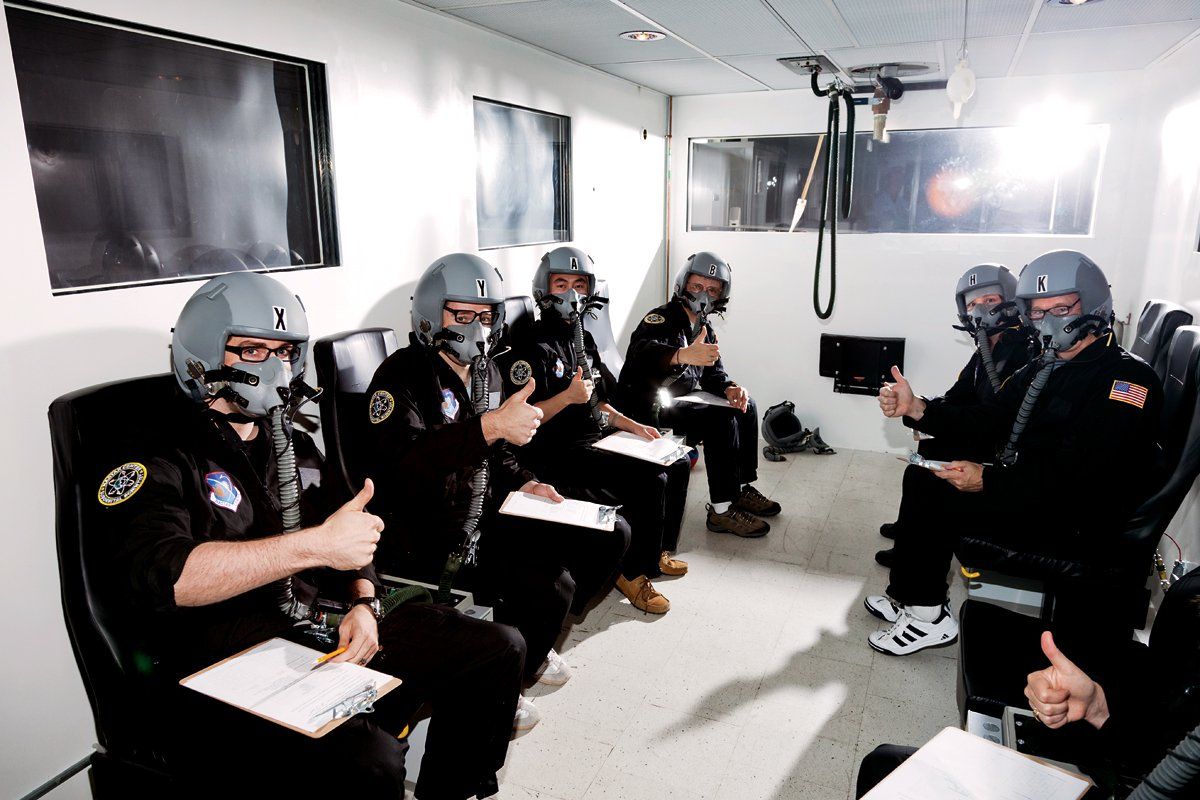
An invisible hand smothers my face and crushes my chest. My vision gets fuzzy, the world goes gray, and my brain cries for oxygen. "Do me a favor," my flight instructor cuts in. "Try to keep your eyes open." I'm strapped in the world's most fearsome human centrifuge, a 25-foot steel gondola that simulates the experience of space flight. My instructor is hunched in a little room with a big red "medical stop" button, coaching me as I feel what it's like to go three times the speed of sound aboard SpaceShipTwo, a plump white missile with passenger seats and a curled wing. The simulator is a one-person pod in a warehouse off the Pennsylvania Turnpike. But the sensations are real: six times my body weight through the sternum, twice what NASA's space shuttle demands. After about a minute, the engine quits and you glide among the stars. That is, if your body doesn't quit on you first.
I'm at the National AeroSpace Training and Research Center, a private facility outside Philadelphia, to see if I have the "right stuff." Not "the uncritical willingness to face danger," chronicled by Tom Wolfe in his book about the first Mercury astronauts. I'm testing my mettle for what's coming next: the era of commercial space, a time when anyone, not just the newsreel heroes of NASA, can explore the galaxy and make a living up there. I'm training to be an astronaut.
With the end of the space-shuttle program (the final mission is slated for this month), NASA snaps its half-century streak as the sole purveyor for spacefaring Americans—and assumes an awkward new role as partner, patron, and competitor of the private sphere. More than a dozen companies (from stalwarts like Boeing to upstarts like SpaceX) are working on space-shuttle replacements, aided by hundreds of millions of dollars from the Obama administration, which hopes to have NASA use these vessels even as the agency develops a longer-range starship of its own.
But the more exciting shift is in the realm of research and tourism, a market worth an estimated $700 million a year by 2021. Hundreds of regular (albeit rich) people have already booked flights, paying between $95,000 and $200,000 each, and next year Sir Richard Branson's Virgin Galactic is expected to send up its first passengers.
That's where the Philadelphia training comes in. Commercial space needs workers: gravity-free professionals to serve tourists, researchers, and the businesses around them. But they won't be Buzz Aldrin types. The demise of the shuttle program has shrunk the NASA astronaut corps by more than 50 percent in the last decade; Endeavour commander Mark Kelly is the latest veteran to resign. Before long, "you're definitely going to see a larger core of commercial astronauts than government astronauts," says Eric Anderson, president of Space Adventures, the only company thus far to put civilians into orbit. The result could be a relationship between NASA and private space-hands much like the Department of Defense has with private soldiers. "We may well head down a path like that," admits NASA spokeswoman Janet Kavandi, the agency's director of flight-crew operations.
But how's it going to work? To get a peek at how commercial space will prepare its people, I signed up for private astronaut training, a three-day NASTAR certificate course for suborbital researchers. Founded in 2006, NASTAR began as a showcase for its parent company, Environmental Tectonics Corp., a leading maker of flight simulators. In 2010 it won Federal Aviation Administration approval for private space training, the first company to do so. The course remains optional, but regulators may require it as part of a company's license. "We're basically leaving it up to the companies," says George Nield, associate administrator for the FAA's office of commercial space transportation.
That's a frightening idea. NASA draws prospective astronauts from the top rungs of professional life, and trains them for at least two years. Despite all the preparation, the agency has lost 24 souls since the dawn of the Space Age. This May, my NASTAR instructor was candid about the comparable perils of commercial enterprise. "They are going to lose ships. That's just the nature of it," said Glenn King, a onetime Special Forces instructor who helped build NASTAR's training programs. "There's a moral balance they need to strike between risk and profit," he said. But he doubts it's being struck.

Of my fellow students, two are scientists who already have tickets to space. Two others head space-related companies. Two others—a former Lockheed Martin engineer and a young civil servant hoping to become one of the first professional private astronauts—hope to break into the field, touted as an acid tab for the national imagination, the key to reinvigorating American interest in the cosmos. But it's fragile, King reminds us. "The first time they fill up a spaceship and bring people back in body bags, it's going to kill the whole industry."
Space training is not for walk-ins. To qualify, I had to sign the mother of all liability waivers, attesting to the fact that I did not suffer from one of a list of disqualifying disorders, including "depression," and submit my body to the pokes and prods of an aero medical examiner, who later sent me a crisp Class 3 Medical Certificate in a letter addressed "Dear Airman." At NASTAR, they fit me for my very own black flight suit. I never felt so prepared.
Then I began the first exercise: altitude training. Inside what looks like a shipping container, the air is remixed to mirror conditions at 25,000 feet, or what mountain climbers refer to as the "death zone." Within five minutes of breathing the deoxygenated air, you feel drunk, sapped of what King calls "useful consciousness." Some people become euphoric, others belligerent. Almost everyone "gets dumb," he says. And the unlucky few suffer an array of medieval fates: exploding eardrums, bursting blood vessels, shattered teeth. Any air bubble in your body triples in size. Have there been incidents here? "I'm not going to lie to you," King says, explaining that you should spit, not swallow, if your molars crack, and if you suffer an aneurysm, "the best thing we can do is get you in an ambulance right away." The nearest hospital is 12 minutes away.

After talk like this, the actual training is anticlimactic. In the chamber, we fool around on cell phones, snap photos, and pass gas (to relieve the pain of enlarged air bubbles). The next day, we walk down a long hallway, past pictures of the famous firsts in American flight, and prepare to go full tilt in the simulator. The vibe is more space geek's 40th-birthday party than Cape Canaveral. We gather in a lounge area, relaxing on leather couches and watching televisions with a live feed of the centrifuge cockpit as each colleague takes his turn. One smuggles in a stuffed animal and a cell phone that plays the theme song from Top Gun. One of the business owners, a man in his mid-50s, gets to the "weightless" portion of the flight and pulls a doughnut hole from his pocket. "A little experiment for Homer Simpson," he crows.
As for me, I enter the pod, strap into the futuristic chair, and babble nervously. There's a click and a rumble as the rocket drops from the mother ship, and an ominous countdown begins. At zero, the booster ignites and I'm supersonic in seven seconds, pancaked by speed. "Breathe for me," King says. After about a minute, the weight falls off, and the stars come out. I can see the curve of the Earth before the ship begins reentry into the atmosphere. The weight piles back on. Then I hear a recorded female voice, one that uses a word once applied to only the awe-inspiring few. "Welcome home, astronaut."
Uncommon Knowledge
Newsweek is committed to challenging conventional wisdom and finding connections in the search for common ground.
Newsweek is committed to challenging conventional wisdom and finding connections in the search for common ground.
About the writer
To read how Newsweek uses AI as a newsroom tool, Click here.





